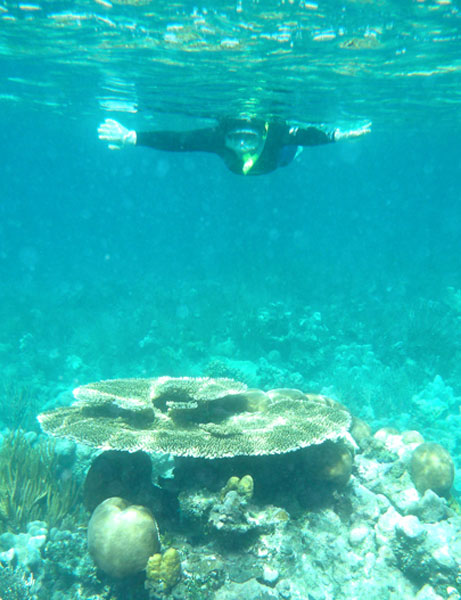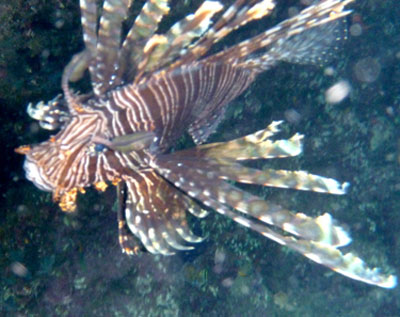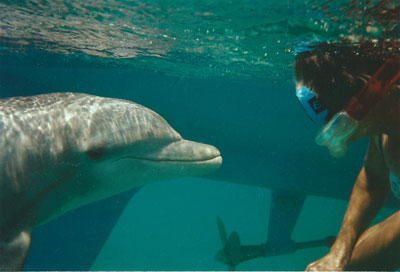Finding good snorkel sites
This item appears on page 28 of the May 2015 issue.
Scuba divers enjoy the availability of schools, guided cruises and even special magazines, but snorkeling aficionados are pretty much left on their own. My husband, George, and I, both 82-year-old grandparents, are certified scuba divers. Claustrophobia caused me to give up scuba diving years ago, so we mostly go snorkeling, but my husband still dives when our children are with us.
We have snorkeled in 50 countries. (If you think about how many countries border a sea AND have relatively warm weather, you’ll realize this isn’t easy to do!) Overall, we think we see more sea life while snorkeling near the surface than we do scuba diving in the depths.
We snorkel in lightweight wetsuits. We always take our own equipment with us, as I’m very small (only 100 pounds) and most masks that are provided leak on me and the fins often don’t fit. I wear kids’ fins.
We lived on a sailboat around Mexico and in the Caribbean for many years and have snorkeled most of those waters. We thought snorkeling off western Mexico was fine until we sailed through the Panama Canal to the Caribbean, where we found fewer fish but a much better background for viewing them. Colorful coral sure beats brown rocks!
Our favorite places to snorkel in the Caribbean were Isla Mujeres, near Cancún, Mexico; Roatán, Honduras; Bonaire (especially Klein Bonaire, reached by a daily tourist boat), and many spots in the eastern islands chain, from Puerto Rico to Trinidad & Tobago.
While researching, I came across a great website, that of Tropical Snorkeling (Port Townsend, WA; www.tropicalsnorkeling.com). Its information is good on Aruba, Bonaire, Curaçao and Belize (places we’re very familiar with and where the snorkeling is very good). It also has descriptions of venues in the US, including Hawaii, but I wouldn’t be able to rate those descriptions since we haven’t snorkeled US waters in almost 40 years.
An excellent website I recently discovered is that of Snorkeling, Etc. (Santa Cruz, CA; 831/254-5001, http://snorkelingetc.com). The owner, Wendy, sets up and accompanies snorkeling trips.
George and I wanted to extend an upcoming Wakatobi trip in Indonesia, and Wendy suggested several Bali resorts. When I told her we had always wanted to snorkel Sipadan Island in Malaysia, she suggested a resort and helped me book it. I wish I had found her earlier.
For those who have the desire and the means to travel farther afield, there are many underwater marvels to behold, and the best way to view them is from a live-aboard snorkel boat.
Don’t make the mistake of joining a dive boat, even though the brochure might state that the trip is fine for snorkelers too. You may be disappointed, as the schedule will be set for giving the divers four or five dives a day, and the dive sites are often too deep for good snorkeling. But all is not lost. We’ve found that some dive boats have a trip or two each year for snorkelers.
Our first snorkel boat trip was in 2010, when I somehow heard about a dive boat that was doing a snorkel-only cruise in the Raja Ampat Islands of northern Indonesia. I had read rave reviews about this region — a pristine archipelago that had just opened to dive boats — so we signed up along with four friends. The area was spectacular, with beautiful, pristine coral plus fish as numerous and colorful as at other places we had snorkeled in the Pacific. (Bidadari, the 12-passenger dive boat we joined there, is no longer managed by the same owners.)
On that same trip, two of our friends joined us on a side trip to Flores, where we hired a boat for three days to take us to see the Komodo dragons. We snorkeled at both Komodo and Rinca islands.
The boat was very basic, consisting of two tiny bunked cabins, no AC and one head where a hand shower provided the only fresh water on board. Nonetheless, a cook with a single-burner stove in the stern managed to whip up three huge, delectable meals a day.
In 2013 we found Bilikiki, another dive boat-turned-snorkel boat, which we enjoyed in the Solomon Islands that July. The Solomons are perhaps our second-favorite snorkel venue, after Raja Ampat. A little larger than the Bidadari, the boat carried 16 passengers along with Ethan Daniels and Lee Goldman, two noted snorkel guides and lecturers.
After the cruise, George and I continued on to Uepi Island Resort (P.O. Box 149, Mt. Eliza, Victoria 3930, Australia; phone +61 3 9787 7904, www.uepi.com) for a few days of snorkeling the reefs. We booked both the cruise aboard the Bilikiki and the lodge through Marsha of Wilderness Travel (Berkeley, CA; 800/368-2794, www.wildernesstravel.com).
The next-best thing to dive boats for snorkeling trips are small cruise ships that have about 100 passengers. A number of these sail in tropical waters.
The advantages of these larger ships include roomier quarters, more food choices (though not necessarily tastier food) and a greater range of travel, with more diverse snorkeling sites. The disadvantage is less snorkeling, since that is only one component of the itinerary, not the main purpose of the trip.
We’ve been on a number of these types of ships. We traveled to New Caledonia and Vanuatu on Clipper Odyssey in November 2006, off the west coast of Africa on Corinthian II (where we snorkeled at São Tomé & Principe) in December 2010, and to New Guinea on the National Geographic Orion in October-November 2012.
In October 2014 we sailed from Easter Island to Tahiti on the Caledonian Sky and snorkeled at several islands in French Polynesia. We continued on to Rarotonga, Samoa and Sri Lanka on our own and snorkeled at them all.
Since all of our snorkeling in these places was from shore, we found the waters murky, the coral ailing and the fish in short supply. Finally, in Oman, our last stop, we went out on a dive/snorkel boat and discovered a profusion of fish and thriving coral!
A number of companies advertise and arrange these trips, including Wilderness Travel, Zegrahm Expeditions, Oceanic Society and National Geographic & Lindblad Expeditions.
When a trip interests us, I always check first with Wilderness Travel. They have a policy of giving a gift for the second and third trips you book with them, 4% off on the fourth, 5% off on the fifth, etc., always with a $500 cap.
Australia’s Great Barrier Reef is so famous that it has a plethora of ways to see it, from one-day rushed and crowded excursion boats to week-long scuba trips, plus there are a number of shore resorts. We couldn’t find a snorkel-only boat there in November 2012, so we spent two nights on the 42-passenger Reef Encounter, a dive/snorkel boat anchored on the reef.
The schedule was, indeed, tailored to diving, but since the ship was anchored in one spot, we snorkelers were able to swim when we pleased. The coral was very good where we were, and the protected fish were totally unconcerned with our proximity. A school of huge bumphead parrotfish swam with us for quite some time!
We did not prebook that trip, nor did we prebook another day trip we took to a different section of the reef. For short excursions like these, we think it’s wiser to wait until you arrive at a location before choosing a boat. That way, you can see the boat and perhaps speak to the crew or passengers who have been aboard.
There are many land-based resorts with good snorkeling, too. If you’re staying for several days or a week, you may want to choose one with a boat that takes you to snorkel reefs farther away.
In the Philippines, to which we flew from New Guinea in November 2012, we couldn’t find a live-aboard boat for the period we would be there, so we stayed at two resorts where we could snorkel either from shore or on jaunts in their boats.
The resorts where we stayed were both excellent. The first was a laid-back place in Dauin called Liquid Dive Dumaguete (P.O. Box 415, Dumaguete City, 6200 Philippines; phone +63 [0] 917 314 1778, www.liquiddumaguete.com), at the southern tip of Negros Oriental. The highlight of that stay was an all-day boat trip to Apo Island with excellent snorkeling.
At the northern end of Palawan Island lies the El Nido area, known for its daily island-hopping excursions to superb dive and snorkel venues. We stayed at the mid-range-price Miniloc Island Resort (Miniloc Island, El Nido, 5313 Palawan, Philippines; phone +63 2 902 5985, www.elnidoresorts.com/miniloc-island-resort/about-miniloc), which has numerous choices of where to go and what to do each day.
An excellent article in ITN by Larry Taylor, “Around the World: Seven Outstanding Snorkeling Spots” (Sept.’07, pg. 72), did much to spike my interest in some far-off snorkeling spots. Perhaps the information I just provided will spur others to take the plunge!
BRENDA MILUM
Olympic Valley, CA



